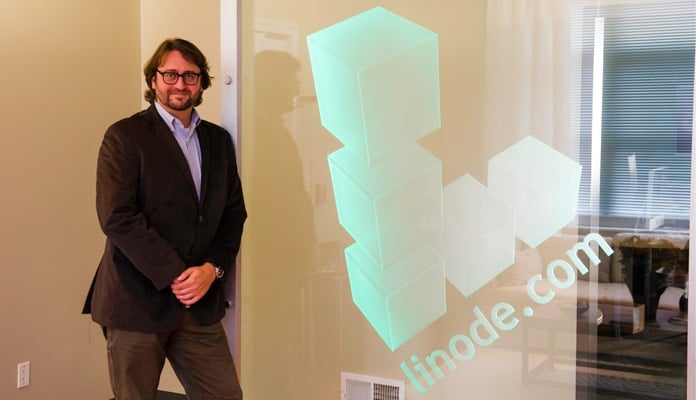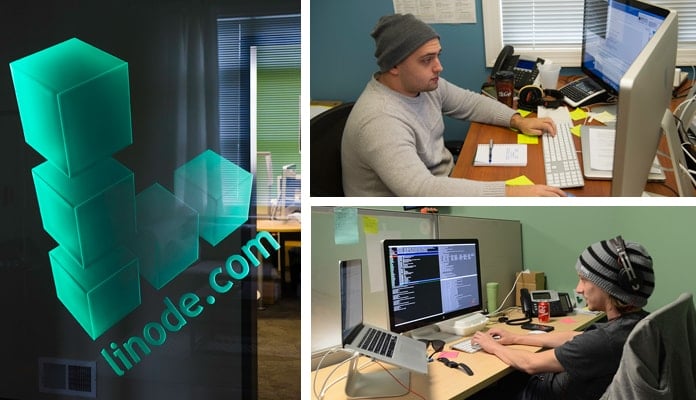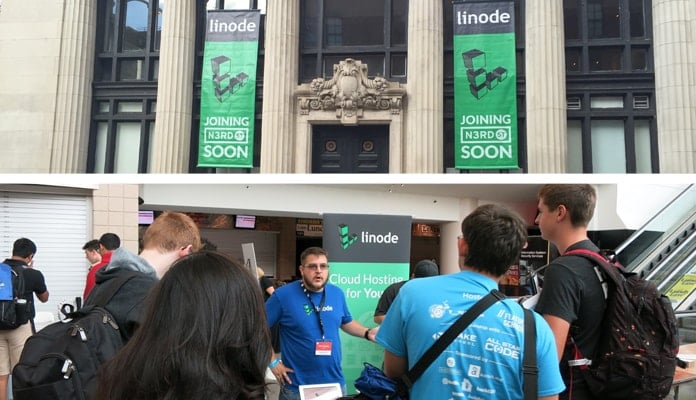
TL; DR: In 2003, Linode entered the cloud hosting scene with an idea that would dramatically shift the scope of cloud hosting for developers. Led by Christopher S. Aker, the Linode team has created a virtualized world where server instances can be spun up and down easily and affordably. Three team members told Linode’s story: dating back to one guy building servers in his garage, and leading up to a team of 80+ crafting solutions to simplify developers’ lives and giving back to the tech community.
In 2003, one man with a passion for programming and a determination to do things differently with virtualization set out to build a company that would inevitably reshape the realm of possibilities for developers using VPSs. With heads-down focus and an eye for simplicity, Christopher S. Aker began building hardware that could be completely customized, computed ‘at-will,’ and spun up or down at a record-low cost. He emerged from his garage six months later and Linode was born.
We got a chance to speak with several key “Linodians,” including Chief Marketing Officer Casey Smith, Network Engineer Alex Forster, and Public Relations Manager Keith Craig. We got the full scoop on the Linode backstory, Chris’s visions for the company, and how the technology itself has been engineered to result in Linode’s outstanding legacy in the industry. We even got a sneak peek at future happenings for the community, including Hackathons, hardware donations in support of colleges with potential Linode applicants, and the company’s move to “N3RD Street.”
The Linode Difference: Technologies Built By Developers, For Developers
Casey, Alex, and Keith explained that Linode was founded upon Chris’s rock-solid understanding of virtualization, as well his propensity for the motto: less is more — and that’s the beauty of a company built by developers, for developers.

In 2003, Christopher S. Aker started a company that would change the way developers could operate virtualized servers.
“Chris has always been a proponent of simplicity and clarity in design and usability,” Casey said, “and that shines through in our culture and in how he runs this business.”
It All Began with Developer #1: Christopher S. Aker & His Vision for Virtualization
The genesis of Linode traces back to one developer in particular: Christopher S. Aker. In the early 2000s, he and Casey had crossed professional paths while working at a company called HealthStream in Nashville, Tennessee; they hit it off and bonded over a shared interest in motorcycles, founding startups, and owning hosting projects on the side. “Chris left in 2003 and essentially gave himself seven months to build a better mousetrap,” Casey said, recalling the lead-up to what would become Linode. “He had a great knowledge of virtualization and what could be done there.”
The Early Challenges: Inventory & Capital
The project Chris had in mind would have been a challenging technological undertaking to pull off in six years, let alone six months. Casey recalled two prominent obstacles being inventory and capital. “He was getting hardware shipped to his garage, putting them together as fast as he could, and then shipping them out, putting them in place, and trying to keep that inventory online,” he said. “It was a constant battle to keep that inventory available.” Not only did he need to keep the inventory available, but he had to do so solo, while also managing support, billing, deployment of new hosts and servers, et cetera. The man was doing EVERYTHING — and it was an entirely bootstrapped operation.
Another obstacle that would understandably present itself would be funding. “It’s capital-intensive to invest in these hosts, the hardware, the network, and the cabinet space,” Casey said. When Tom Asaro, Chris’s life-long friend and now Linode’s Chief Operating Officer, came along as the third employee, he built servers out of his own garage too. “It was totally bootstrapped and 100 percent owned by a developer, built for developers,” Casey said.
The End Result: A Bootstrapped Operation Built with Developers In Mind
Now over 10 years later, that head-down work ethic and hefty investment has certainly paid off. It’s been said that the best marketing you can do is to simply build a product that works and that helps people. “Keep your nose to the grindstone, make something that’s good, that works, and that solves problems,” Casey said, describing the company motivation early on — “and the rest will take care of itself.” There was and is a lot of truth in that.
News of this new-found innovation that was engineered by a developer to make the lives of fellow developers and SysAdmins easier spread like wildfire. Linode made a huge splash in the development world and they continue to make waves today.
Linode in 2016: Improvements to the Fortitude of their Network
Casey, Alex, and Keith shared some exciting changes coming up in Linode’s future, though these changes are tied to some unfortunate events in their recent past. Nearing the end of 2015, the team had been planning some infrastructural upgrades — then 12 days of 100+ DDoS attacks over the holiday season moved these planned upgrades to Priority #1 status.
The 12 Days of DDoS: The Personal Experience of the Network Engineer
Over the holidays, Linode experienced over 100 DDoS attacks to their network, culminating in six cumulative hours of downtime across their datacenters (with the exception of the Atlanta location, which experienced 30 hours alone). Alex, one of three network engineers who spent their holidays working quite literally around the clock trying to get the networks back online (and stay there), shared his experience with us. “It’s something very personal,” he said. “With that being said, after the datacenter had already gone down, some of the fear in thinking, ‘Are we going to break things?’ sort of goes away and the thought just becomes, ‘Well, we can’t make it worse.'” Alex’s explanation of the emotional experience was a melting pot of remorse for the customers whose holidays were upset by the attacks, frustration that his own holiday was tainted by the foul play, and determination that the hackers were not going to win.

Network Engineer Alex Forster (upper right) gave his insights into the recent DDoS attacks and Linode’s comeback plan.
The reality is that anyone who wants to initiate a DDoS attack can do so for 20 bucks with a credit card (or use bitcoins for a little anonymity). Any and every host is going to have to deal with DDoS threats at some point, especially if they’re a provider with success under their belt. “It was definitely targeted at us, rather than any of our customers,” Alex said. “It was meant to take us down.” Linode rallied, however, and Alex and his team were able to locate and reinforce the weak spots being targeted relatively quickly. He explained that there really isn’t a protocol for handling something like this. “We sort of had to move as the attack methods changed,” he said. “We’d think, ‘OK, it’s finally over; we’ve cut them off from the vector they’re attacking’ — and then they’d come in another way.”
The Comeback: New Fiber Network, Tier 1 Providers, & Enhanced Connectivity
Though the 12 Days of DDoS experience was crippling at the time, the team is excited about the resulting infrastructural reinforcements to come. “We’re quadrupling the amount of Internet connectivity we have available in each datacenter,” Alex reported. “We’re also dramatically improving the quality of that Internet connection.”
Linode will be moving to well-reputed Tier I providers and throwing a lot of capital into building out an entirely new fiber network — dramatically improving the customer experience. “At the end of the day, these servers need the Internet — the whole point of a server is to serve stuff over the Internet,” Alex said. “We’re going to be 10-fold enhancing the quality of our connectivity.”
Three Technologies that Showcase the Linode Focus on Simplicity
Casey, Alex, and Keith told us about several of the key Linode technologies, including their API and solutions for monitoring and load-balancing. We discussed their significance to developers, the thought behind their unique build-outs, and how they stand out in the cloud hosting market.

Christopher S. Aker founded Linode on the idea that cloud hosting could be made simpler and cheaper for devs.
Each technology is innovative and built with developers in mind — true to the Linode style.
1. Cheaply Spinning Cloud Servers Up & Down via an API: The Game-Changer
Linode was the first in the industry to offer a highly-available and equally affordable option for developers to easily manage and deploy servers quickly (and they could do so via an API). This opened doors to dynamic scaling potential, the ability to utilize resources exactly as you please, and top-tier performance at a price point that’s hard to beat. “In terms of performance for the dollar, we challenge anyone to stack up to the level we provide,” Casey said.
Code Written Entirely In House — Complete Visibility, Control, & Easy Feature Add-Ons
Instead of using OpenStack, VMware, or the like to code out their technology stack, Linode writes it all in house. This gives them complete visibility and understanding of every line of their code, while also allowing them to roll out new features a lot faster. Alex shared that one of the internal challenges, however, is keeping the code compatibile with both Xen and KVM. “We’re in the middle of a transition away from Xen and towards KVM for performance and security reasons,” he explained. “Having two different types of virtualization out there basically necessitates that a large amount of the core code be able to work with both hypervisors.” It’s challenges like this that not only showcase the expertise of the Linode team but also merit the focus on simplicity. This brought up some exciting news: an imminent rewrite to the Linode API is coming!
Coming Soon! An API Rewrite — The Risks, Rewards, & How Testing is Done
Any dev-savvy readers are probably thinking: a rewrite to a core product?! Sounds real risky — and they’d be right. “It’s a big undertaking, but it’s also something that’s been overdue,” Alex said. This upcoming enhancement is a classic example of a Linode upgrade via thoughtful reduction (rather than adding more features). Linode always looks for ways to simplify processes and the number of touch points for developers and System Administrators. Users will soon be able to control every aspect of their Linode via the API. “Essentially, anything you can do with the Linode Manager, you’ll be able to do with an API call,” Casey explained.
Casey also announced that the team even plans on open-sourcing the classic Linode Manager (the web-based control panel for managing your virtualized Linode servers). “It’s a full rewrite of pretty much all the manager functionality,” Alex added. “It’s going to mean that we can bring out features a lot faster.” Needless to say, you can expect even more robust technological capabilities with this update, but we imagined testing this new code would be an interesting ordeal.
“I wouldn’t call us TDD (Testing-Driven Development), but we’re definitely using modern software practices,” Alex said. “Everything’s got unit tests. We have an immense amount of internal testing going on.” He also added that there will probably be a lengthy beta period in which customers can try out the new system following its release.
2. All-In-One Monitoring with Longview: The “Google Analytics For Your Server”
Another outstanding technology brought to you by developers, for developers is Linode’s panel for managing all of your servers: Longview. “LongView was really an experiment at first — a fun thing we wanted to roll out — and then it progressed,” Casey said.
A Comprehensive Look at ALL of Your Linux-Based Systems
The team members we spoke with clarified that Longview isn’t keeping an eye on anything that a dev couldn’t set up monitoring for him/herself; however, the beauty of Longview is that peace of mind that comes with seeing all of your systems in one place. Longview monitors the usual suspects: Apache, PHP, et cetera, but you can also monitor any other Linux-based system you install. It’s an affordable way to easily keep watch over ALL of your systems, even AWS instances.
A Graphical Visual of Performance Bottlenecks
Longview was built earlier in the Linode lifespan, as evidenced by the fact that it’s written almost entirely in Perl (Alex noted that they’ve since transitioned more towards Python). Since Longview’s release, however, the program has developed into this incredibly useful tool (when used appropriately) for troubleshooting and rectifying performance issues. “The idea behind it is to help users find performance bottlenecks, and to do so in a graphical way,” Casey said. “I always described it as ‘Google Analytics for your server.'”
3. Scaling with NodeBalancers: The “Set and Forget” Load-Balancing Solution
If you want to scale your application or website to be used by 1,000s+ of users, load-balancing is going to become necessary. Linode came up with their own load-balancing solution: NodeBalancers, which are designed to make scaling simple and affordable.
The Ability to Scale without Worrying About Your Site Staying Up
If you’ve built an application and it’s starting to grow, you need to be able to handle maintenance when required while maintaining reliability and redundancy. “You usually become less of a hobbyist or a tinkerer at that point and more focused on the elements of the business that make sure you stay running for your user base,” Casey said. “It’s those types of things that we look into and say, ‘How can we make that easy and affordable?'”
The Peace of Mind of Paying for a Service that Just Works
The team said NodeBalancers were a no-brainer idea for them to concoct. Alex explained that they wanted to mitigate the potential for problems that could occur if users were to try to handle scaling and maintenance themselves. “It’s based on the idea that it’s preferable to pay for something that just works rather than set up something that you have to constantly worry about,” he explained the developer’s perspective. “The more we can do for you, the more you’re going to enjoy the experience,” he followed up with Linode’s point of view.
Final Words on Linode & Their Impact on the “N3RD Community”
Through our chat with Casey, Alex, and Keith, the Linode focus on simplifying hosting for developers was palpable (in stories of their startup, their struggles, and their plans for the future). They’re excited to expand into a new office location in downtown Philly: a beautiful old bank building located on North 3rd Street (affectionately coined “N3RD Street”). Here in the heart of the “N3RD Community,” they plan to continue challenging the hosting community and look forward to feeding off fellow techy trendsetters.
Supporting Potential New Hires with College Hackathons & Hardware (ITWP)
Leading by example, Linode has even found a way to make a positive impact with their used hardware. Around 2014, Keith inspired and launched a program called IT Workforce Preparation (ITWP). “We had started to get into Hackathons at the college level and made the supposition that maybe some of the computer science departments or the colleges themselves could use some fairly kickin’ hardware,” Keith said. It made sense that most colleges either wouldn’t have the means to afford hardware this new (~five years old), or if they did, they wouldn’t actually be spending the money on computers.

Linode impacts potential new hires of the future by supporting college Hackathons and donating used hardware.
Linode’s old hardware (with the exception of drives) has now been donated to seven colleges and universities in the Northeast. As an example, the New Jersey Institute of Technology (NJIT) accepted 420 servers (an estimated $1.2M value), which they integrated into their existing cluster to increase their capacity 1,000 percent.
“TL; DR: The hardware that we cycled out after a couple of years, while obsolete for the hosting market, is wonderfully fit and prime for a college market,” Keith explained. “We feel great, because (1) we’re giving back to a community that extends the life of the hardware, (2) it’s recycling materials so we’re not wasting, and (3) it’s greatly improving what the colleges can do — which ultimately gives us better potential employees.”
Joining the Linode Team
What began as one man’s vision for virtualization is now a team of 80 innovators and they’re looking to grow their membership. “You’ve caught us at a unique time in our history here,” Casey concluded. “We’re in the age of fortification — making things better and more reliable for our customers.” If you’d like to become the next Linode innovator and make a difference for developers, apply on their website today!
HostingAdvice.com is a free online resource that offers valuable content and comparison services to users. To keep this resource 100% free, we receive compensation from many of the offers listed on the site. Along with key review factors, this compensation may impact how and where products appear across the site (including, for example, the order in which they appear). HostingAdvice.com does not include the entire universe of available offers. Editorial opinions expressed on the site are strictly our own and are not provided, endorsed, or approved by advertisers.
Our site is committed to publishing independent, accurate content guided by strict editorial guidelines. Before articles and reviews are published on our site, they undergo a thorough review process performed by a team of independent editors and subject-matter experts to ensure the content’s accuracy, timeliness, and impartiality. Our editorial team is separate and independent of our site’s advertisers, and the opinions they express on our site are their own. To read more about our team members and their editorial backgrounds, please visit our site’s About page.

